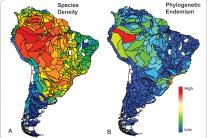The University of Louisiana at Lafayette has taken its place in the top level of the nation’s research institutions
UL Lafayette Researcher Finds Answers to Origins of Most Diverse Fish Fauna on Earth
Wed, 01/25/2023 - 11:06amRecent research by Dr. James Albert, professor of ecology and evolution at the University of Louisiana at Lafayette, sought to understand the origins of the megadiversity of freshwater fish fauna in South America.
What he and his colleagues discovered is that abrupt increases of species evolution coincided in time and place with major mountain uplifts and river re-arrangements.
The research by Prof. Albert and colleagues across the country was published earlier this month in the journal: Proceedings of the National Academy of Sciences.
Scientists integrated an unprecedented dataset of about 5,000 species with a newly complied, time-calibrated evolutionary tree of South American freshwater fishes ¬– the most species-rich continental vertebrate fauna on Earth – to track the evolutionary processes associated with river and sea events over 100 million years.
“The effects of river network re-arrangements on dispersal and lineage diversification were poorly understood,” said Albert. “Our results support the hypothesis that landscape dynamics, which shaped the history of drainage basin connections, strongly affected the assembly and diversification of basin-wide fish faunas.
“Species in the Western Amazonia originated faster and persisted longer than those in other regions, substantially enhancing the exceptional diversity of aquatic organisms across the whole continent,” he added.
The study used the most complete datasets of geographic distributions and evolutionary relationships of South American fishes to date, to track the influence of the geological history on the origins, extinctions, and interchanges of these fishes over the past 100 million years.
Findings note that five abrupt shifts in diversification rates occurred during the Paleogene and Miocene periods – between 30 and 7 million years ago – in association with major landscape evolution events. These events include the formation of several mountain ranges in South America: Serra do Mar, Serra da Mantiqueira, and the Andes.
Read the full paper here: Landscape dynamics and diversification of the megadiverse South American freshwater fish fauna.

